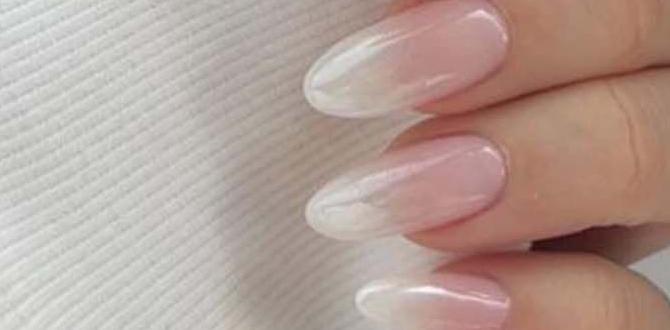Nautical striped blue nails are a chic and versatile way to add a touch of seaside flair to your look. This guide breaks down essential designs, offering easy-to-follow steps and creative inspiration perfect for beginners. Get ready to master this classic nail trend!
Dreaming of a manicure that evokes breezy ocean days and elegant seaside charm? Nautical striped blue nails are a timeless choice that brings a sophisticated yet playful vibe to any outfit. But if you’re new to nail art, the idea of creating those perfect stripes might seem a little daunting. Don’t worry! With a few simple techniques and our easy-to-follow tips, you’ll be creating stunning nautical looks that look professionally done, even if you’re just starting out. Get ready to dive into the world of effortless elegance and learn how to rock this beautiful trend!
Your Nautical Nail Art Journey Begins Here!
Who says you need to be a professional nail artist to sport gorgeous, themed nails? The beauty of nautical striped blue nails is their inherent simplicity and striking visual appeal. They’re perfect for a summer vacation, a themed party, or honestly, just because you love a classic, clean look. We’re going to cover everything from the essential tools you’ll need to a variety of designs that are totally achievable at home. Think crisp lines, varying shades of blue, and perhaps a touch of white or red to really make them pop!
Essential Tools for Perfect Nautical Stripes
Before we start painting, let’s gather our supplies. Having the right tools makes all the difference, especially when you’re aiming for precision. Don’t feel overwhelmed; many of these are staples you might already have!
- Base Coat: This protects your natural nails from staining and helps your polish adhere better.
- Top Coat: Seals your design, adds shine, and helps your manicure last longer.
- Nail Polish: You’ll need your base blue (or several shades!), white, and maybe a pop of red for accents.
- Striping Tape or Decals: This is your secret weapon for super-straight lines! You can find thin striping tape in craft stores or online. Nail decals with pre-made stripes work too!
- Fine-Tipped Nail Art Brush or Dotting Tool: For freehand stripes or adding small details.
- Nail Polish Remover & Cotton Swabs: For cleaning up any mistakes (we all make them!).
- Clean-Up Brush or Orange Stick: For meticulous edge tidying.
Choosing Your Perfect Nautical Blues
The “nautical” theme often brings to mind classic navy and crisp white, but there’s so much room to play! Consider these color palettes:
| Color Palette | Vibe | Description |
|---|---|---|
| Classic Navy & White | Timeless & Chic | The quintessential nautical look. Deep navy paired with bright white stripes. |
| Aqua & Cream | Soft & Serene | Lighter, more pastel blues with a creamy white for a gentle, beachy feel. |
| Cobalt & Silver | Modern & Edgy | A vibrant cobalt blue with metallic silver stripes for a sophisticated twist. |
| Teal & Coral Accents | Playful & Bold | A rich teal base with white stripes, and a coral accent nail for a surprising pop of color. |
Experimenting with different shades of blue allows you to tailor the nautical theme to your personal style and the occasion. A deeper navy feels more formal, while a lighter aqua can be more casual and summery. Don’t forget metallics like silver or gold for an extra touch of glam!
Essential Nautical Striped Blue Nail Designs for Beginners
Ready to get creative? These designs are perfect stepping stones for anyone new to nail art. They offer that essential nautical feel without requiring complex techniques.
1. The Classic Horizontal Stripe
This is the absolute cornerstone of nautical nail art. It’s simple, effective, and instantly recognizable.
How to Create Classic Horizontal Stripes:
- Prep Your Nails: Start with clean, dry nails. Apply a base coat and let it dry completely.
- Choose Your Base Color: Apply two coats of your chosen blue polish and let it dry until it’s tacky but not wet.
- Apply Striping Tape: Carefully lay a strip of nail striping tape horizontally across your nail. Press down firmly to ensure a good seal. You can place it anywhere – near the cuticle, in the middle, or near the tip.
- Paint Over the Tape: Apply your contrasting color (usually white) over the entire nail, ensuring it covers the tape. Apply a thin second coat if needed for opacity.
- Remove the Tape: While the second coat of polish is still wet, carefully peel off the striping tape at an angle. This is crucial to avoid chipping the color.
- Let it Dry: Allow the polish to dry completely.
- Top Coat Magic: Apply a thin layer of top coat to seal the design and add shine.
Pro Tip: For perfectly straight lines every time, wait for the base blue to be fully dry before applying the tape. This prevents the tape from lifting any polish. If you don’t have striping tape, you can use a fine-tipped brush and white polish to paint a straight line, but patience is key!
2. The Vertical Stripe Accent
Vertical stripes can elongate the appearance of your fingers, making them look even more elegant. This is a great design to use on just one or two accent nails.
How to Create Vertical Stripes:
- Prep: Base coat, then apply your chosen blue polish to all nails. Let dry.
- Accent Nail Focus: On your accent nail (usually the ring finger), decide where you want your vertical stripe. You can go from cuticle to tip, or create a thinner stripe off to the side.
- Using Striping Tape: Apply a strip of striping tape vertically. Gently press it down.
- Paint Over: Apply your contrasting color (white or even a metallic like silver) over the tape.
- Peel Carefully: While the paint is still wet, carefully peel off the striping tape.
- Dry & Seal: Let dry and apply a top coat.
Alternative (Freehand): If you’re feeling a bit more adventurous, use a very fine nail art brush and your white polish. Start at the cuticle and draw a straight line up to the tip. Practice on a piece of paper first! It’s worth investing in good quality nail art brushes. You might check out resources from reputable beauty suppliers like Nail Art Brushes: Your Complete Guide for tips on selecting the best tools.
3. Pin-Striped Elegance
This design uses very thin, delicate stripes for a sophisticated, understated nautical look. It’s less about bold blocks of color and more about subtle detail.
How to Create Pin Stripes:
- Base Color: Apply two coats of your favorite blue polish and let it dry completely until it’s not tacky.
- Fine Lines: Using a super-fine nail art brush and white polish, carefully paint thin, parallel lines across your nail. Aim for 2-3 thin lines per nail. You can place them horizontally or vertically.
- Patience is Key: Go slow and steady. It’s better to have fewer well-placed lines than many messy ones.
- Let Dry Thoroughly: Ensure the fine lines are completely dry before the next step.
- Seal the Deal: Apply a thin, smooth layer of top coat.
Expert Tip: For extra fine lines, consider using a specialized liner polish which has a very thin brush built-in, or dilute your regular polish slightly with a nail art thinner (not remover!).
4. The Full Stripe Mani
For the ultimate nautical impact, why not cover all your nails in bold stripes? This is where striping tape really shines.
How to Create a Full Stripe Mani:
- Base Color Brilliance: Apply your base blue polish and let it dry.
- Tape Application: Cut strips of tape and lay them across your nail in a pattern. You can alternate directions (some horizontal, some diagonal) for added interest. Ensure the tape is firmly adhered.
- Paint Away: Apply a coat of white polish over the entire nail.
- The Reveal: While the white polish is still wet, carefully peel off all the tape.
- Finishing Touches: Let dry and seal with a glossy top coat.
Look for Success: This design works best when the tape is applied precisely and removed at the perfect moment. Don’t be afraid to practice on paper first. For more information on mastering nail polish application and techniques, resources from official government health sites like the CDC on Nail Care can offer insights into hygiene and best practices that will benefit your manicure’s longevity.
5. Nautical Accents: Anchors & Dots
Stripes are great, but sometimes a little extra detail can elevate your nautical theme. Anchors, dots, and even small waves can add character.
Adding Nautical Accents:
Anchor Design:
- Paint your nails with your chosen blue and white stripe design.
- Once dry, use a fine-tipped brush and black or navy polish to paint a small anchor shape on an accent nail. You can find simple anchor stencils online or simply freehand a basic outline.
- Alternatively, use anchor-shaped nail art studs or decals for an easy, professional finish.
Dotting Tool Fun:
- Use your striped nails as a base.
- With a dotting tool and white or red polish, add small dots along the cuticle line or the tip of a nail. This mimics a sailor’s uniform or adds a playful touch.
Seashells and Stars: Consider tiny seashell or star charms pressed into wet top coat on an accent nail for an extra oceanic touch. These small additions can make a big difference!
Advanced Nautical Stripes: Taking It Up a Notch
Once you’re comfortable with the basics, you might want to try some slightly more intricate designs that still capture the nautical spirit.
1. The French Tip Stripe
Give the classic French manicure a nautical twist by incorporating stripes into the tip.
How to Create French Tip Stripes:
- Base Coat: Apply your base and then a full coat of a soft blue or nude polish. Let dry.
- French Tip Line: Use striping tape or a fine brush to create a clean white line across the tip of your nails, mimicking a French tip.
- Stripe the Tip: Once the white tip is dry, apply thin blue stripes horizontally across the white tip.
- Alternative: Paint the entire tip white, then apply thin blue stripes over it once dry.
- Seal: Top coat for durability and shine.
This creates a very chic and subtle nod to the nautical theme.
2. Gradient Blue Stripes
Instead of just two colors, use a gradient of blues for your stripes, adding depth and interest.
How to Create Gradient Stripes:
- Base: Apply a light base polish (like white or a very pale blue).
- Gradient: Use a makeup sponge to gently dab two or three shades of blue polish onto the nail, blending them together to create a gradient effect. YouTube tutorials are excellent for mastering nail gradients!
- Add Stripes: Once the gradient is dry, use striping tape or a fine brush to add thin white or navy stripes over the gradient.
- Seal: Top coat to smooth everything out.
This looks incredibly professional and is a great way to showcase multiple shades of blue.
3. The Diagonal Delight
Why stick to horizontal or vertical? Diagonal stripes can add a dynamic feel to your nautical nails.
How to Create Diagonal Stripes:
- Base: Apply your base blue polish.
- Tape Placement: Carefully place striping tape diagonally across your nail. You can do one thick stripe or multiple thin ones.
- Paint & Peel: Apply your contrasting color over the tape and peel it off while wet.
- Repeat (Optional): For a criss-cross effect, let the first stripe dry, apply another piece of tape over it, and paint another diagonal stripe in a different direction or color.
- Final Seal: Top coat.
This design feels particularly modern and stylish.
Maintaining Your Nautical Manicure
Getting beautiful nails is only half the battle! Keeping them looking great is just as important.
- Wear Gloves: When doing household chores, especially washing dishes, wear rubber gloves. Water and harsh cleaning chemicals can break down polish and weaken your nails.
- Avoid Hard Surfaces: Try not to use your nails as tools to pry things open or scrape surfaces. This can lead to chips and breaks.
- Moisturize: Regularly apply cuticle oil and hand lotion. This keeps your nails and the skin around them healthy, reducing the chance of breakage and making your polish look smoother. A good cuticle oil can be found from many reputable beauty brands. For instance, brands like Essie and OPI offer excellent cuticle care products.
- Touch-Ups: If you notice a tiny chip, you can sometimes fix it with a small dab of polish and a dot of top coat.
Troubleshooting Common Nail Art Woes
Even with the best intentions, nail art can sometimes present challenges. Here are some common issues and how to fix them:
- Smudged Polish: This is most common when removing tape or rushing the drying process. Always remove tape when the polish is wet, and be patient! If you smudge, dab a tiny bit of polish onto the affected area. For small smudges, a clean-up brush dipped in nail polish remover can sometimes fix it.
- Peeling Tape Leaving Jagged Lines: This happens when the base polish is too dry, or the tape isn’t pressed down firmly. Try applying the tape to slightly tacky polish, or ensure it’s firmly pressed with an orangewood stick. If the line is jagged, you can try to “clean it up” with a very fine brush and your base color.
- Bubbles in Polish: This can be caused by applying polish too thickly, shaking the bottle vigorously, or applying polish while the previous layer is still too wet. Ensure each layer is dry enough, and use thin coats.
- Polish Not Sticking to the Nail: Ensure your nails are clean and free of oils before applying polish. A good base coat is essential.
Remember, practice makes perfect! The more you experiment with these techniques, the better you’ll become, and the easier these fixes will be.
Frequently Asked Questions (FAQ)
Q1: How do I get perfectly straight stripes without striping tape?
A: Use a very fine-tipped nail art brush or a liner polish. Start with a clean, dry nail. Dip your brush in polish, wipe off excess, and practice drawing a straight line on a piece of paper first. Hold your hand steady and try to draw the line in one fluid motion from cuticle to tip. Clean up edges with a cotton swab dipped in nail polish remover.
Q2: Can I use regular nail polish for these designs?
A: Yes! Regular nail polish works perfectly for nautical striped designs. You’ll just need patience for drying times. Gel polish offers longer wear and a harder finish, but traditional polish is great for beginners and easy to remove.
Q3: How long should I let my polish dry between coats?
A: For regular polish, wait at least 2-5 minutes between coats. It should be dry to the touch but still slightly tacky for techniques like applying striping tape. Always let the final coat dry completely (10-15 minutes) before applying top coat or engaging in activities.
Q4: What’s the best way to clean up mistakes?
A: A small, flat brush or an orangewood stick with a tiny piece of cotton wrapped around the tip, dipped in nail polish remover, is ideal. Gently swipe away the excess polish from the skin around your nail. For mistakes on the nail itself, sometimes carefully dabbing with your base color polish can fix minor errors.



